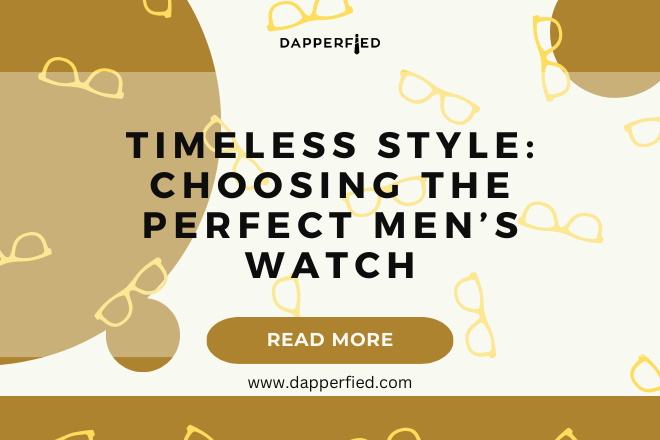Men's Style
Men’s Watch Size and Fit Tips: Finding the Perfect Fit
When it comes to choosing the right watch, size matters. The size of a watch is typically determined by the diameter of the case, which is measured in millimeters. Watches come in a variety of sizes, ranging from small, delicate timepieces to large, statement-making watches. It’s important to consider your wrist size and personal style when selecting a watch size. A larger watch may be more suitable for someone with a larger wrist, while a smaller watch may be more flattering on someone with a petite wrist. Additionally, the size of the watch should complement your overall look and style. Understanding watch sizes is crucial in finding the perfect timepiece that not only fits well but also looks great on your wrist.
When it comes to watch sizes, there are no hard and fast rules. However, there are some general guidelines to consider. For men, a standard watch size is typically between 38mm and 42mm, although larger sizes are becoming increasingly popular. For women, watch sizes tend to be smaller, ranging from 26mm to 36mm. It’s important to note that these are just guidelines, and personal preference should ultimately dictate the size of the watch you choose. Some people prefer the look of a larger, more substantial watch, while others may prefer a smaller, more understated timepiece. Ultimately, the key is to find a watch size that feels comfortable and looks proportionate on your wrist.
Key Takeaways
- Watch sizes are typically measured in millimeters and can range from small to oversized.
- The right fit for your wrist is important for comfort and style, with the watch face not extending beyond the width of your wrist.
- Band width should be proportional to the size of the watch case, with larger cases typically requiring wider bands for balance.
- Case thickness can affect the overall look and feel of the watch, with thinner cases often being more comfortable for everyday wear.
- Factors to consider for comfort include the weight of the watch, the material of the band, and any potential skin allergies.
- Adjusting the watch for a perfect fit may involve adding or removing links from the band or adjusting the clasp for a secure and comfortable fit.
- When trying on watches, consider the overall look, feel, and comfort on your wrist, and don’t be afraid to ask for adjustments or try different styles.
Finding the Right Fit for Your Wrist
Finding the right fit for your wrist is essential when choosing a watch. A watch that is too loose can slide around and feel uncomfortable, while a watch that is too tight can be restrictive and leave marks on your skin. To find the perfect fit, it’s important to measure your wrist accurately. You can use a flexible tape measure or a piece of string to measure the circumference of your wrist. Once you have your wrist measurement, you can use it as a guide when shopping for a watch. Keep in mind that different styles of watches may fit differently, so it’s important to try on different styles and sizes to find the best fit for your wrist.
When trying on a watch, pay attention to how it feels on your wrist. The watch should fit snugly without feeling too tight or too loose. You should be able to fit one finger between the watch and your wrist without it feeling too tight. Additionally, the watch should sit comfortably on your wrist without sliding around or digging into your skin. If you’re unsure about the fit, don’t hesitate to ask a sales associate for assistance. They can help you find the right size and style that will fit your wrist perfectly.
Choosing the Right Band Width
In addition to the size of the case, the band width is another important factor to consider when choosing a watch. The band width refers to the width of the strap or bracelet that attaches to the case of the watch. Band widths can vary significantly, ranging from narrow, delicate straps to wide, substantial bracelets. The band width you choose should complement the size of the case and the overall style of the watch. A larger case may require a wider band to maintain balance and proportion, while a smaller case may look best with a narrower band.
When choosing a band width, it’s important to consider your personal style and comfort preferences. A wider band can make a bold statement and add a masculine touch to a watch, while a narrower band can create a more delicate and feminine look. Additionally, the material of the band can also impact the overall look and feel of the watch. Leather bands are classic and versatile, while metal bracelets can add a modern and sophisticated touch. Ultimately, the band width you choose should complement the overall style of the watch and feel comfortable on your wrist.
Considering Case Thickness
| Case Thickness | Impact |
|---|---|
| Thin | Sleek and lightweight design |
| Medium | Balance between style and durability |
| Thick | Robust and sturdy construction |
In addition to the diameter of the case, the thickness of the case is another important factor to consider when choosing a watch. The case thickness refers to how tall or deep the watch is from the back of the case to the top of the crystal. Watches come in a range of case thicknesses, from slim and sleek to chunky and substantial. The thickness of the case can impact how the watch sits on your wrist and how it feels when worn. A thicker case may feel more substantial and make a bolder statement, while a thinner case may feel more lightweight and understated.
When considering case thickness, it’s important to think about your personal style and comfort preferences. A thicker case can add a masculine and sporty touch to a watch, while a thinner case can create a more elegant and refined look. Additionally, the thickness of the case can impact how the watch fits under sleeves and cuffs. If you plan to wear your watch with dress shirts or jackets, you may want to consider a thinner case that will slide easily under clothing. Ultimately, the case thickness you choose should complement your personal style and feel comfortable on your wrist.
Factors to Consider for Comfort
When choosing a watch, comfort should be a top priority. A comfortable watch is one that feels good on your wrist and doesn’t cause any irritation or discomfort. There are several factors to consider when it comes to comfort, including the weight of the watch, the materials used in its construction, and how it sits on your wrist. A heavy watch may feel cumbersome and uncomfortable for some people, while others may prefer the substantial feel of a heavier timepiece. Additionally, certain materials used in watch construction may cause skin irritation for some individuals, so it’s important to consider any sensitivities you may have when choosing a watch.
The way a watch sits on your wrist can also impact its comfort level. A well-fitted watch should sit comfortably on your wrist without sliding around or digging into your skin. The shape of the case and how it curves around your wrist can impact how comfortable the watch feels when worn. It’s important to try on different styles and sizes of watches to find one that feels comfortable and looks great on your wrist. Ultimately, comfort is subjective, so it’s important to choose a watch that feels good for you personally.
Adjusting the Watch for a Perfect Fit

Once you’ve found the perfect watch, it’s important to ensure that it fits properly on your wrist. Many watches come with adjustable straps or bracelets that can be resized to fit your wrist perfectly. If you need to adjust the size of the band, it’s best to have it done by a professional jeweler or watchmaker to ensure that it’s done correctly. They can remove links from metal bracelets or punch additional holes in leather straps to achieve the perfect fit.
If you have a metal bracelet that needs resizing, it’s important to have it done by someone with experience working with watches. Metal bracelets often require special tools and expertise to adjust properly without damaging the links or clasp. Leather straps can also be adjusted by adding extra holes or trimming excess length for a custom fit. Once your watch has been adjusted to fit your wrist perfectly, you’ll be able to enjoy wearing it comfortably and confidently.
Tips for Trying on Watches
When trying on watches, there are several tips to keep in mind to ensure that you find the perfect fit for your wrist. First, take your time trying on different styles and sizes of watches to see what looks and feels best on your wrist. Don’t be afraid to ask for assistance from a sales associate if you’re unsure about which size or style is right for you.
It’s also important to consider how the watch will fit into your daily life and wardrobe. If you plan to wear your watch with dress shirts or jackets, consider how it will fit under sleeves and cuffs. Additionally, think about any activities or sports you may participate in while wearing the watch and choose a style that will be comfortable and practical for those activities.

Finally, don’t forget to consider your personal style when choosing a watch. The right watch should not only fit well but also complement your overall look and aesthetic. Whether you prefer a classic leather strap or a modern metal bracelet, there are countless options available to suit your personal style and preferences.
In conclusion, finding the perfect watch size and fit is essential for both comfort and style. By understanding different aspects such as case size, band width, case thickness, comfort factors, adjusting for perfect fit and trying on tips will help you make an informed decision when choosing a new timepiece that will look great and feel comfortable on your wrist for years to come.
If you’re looking for more tips on men’s fashion, be sure to check out this article on men’s grey suits. It offers great advice on how to choose the perfect suit for any occasion, including tips on fit and style. Whether you’re looking for a classic grey suit for the office or a more casual option for a night out, this article has you covered.
FAQs
What is the ideal watch size for men?
The ideal watch size for men varies depending on wrist size and personal preference. However, a common guideline is that the watch case should be proportionate to the wrist, with the lugs not extending beyond the edges of the wrist.
How do I measure my wrist for a watch?
To measure your wrist for a watch, use a flexible tape measure or a piece of string to wrap around the wrist at the widest point. Take note of the measurement and use it as a guide when selecting a watch size.
What are some tips for finding the right watch fit?
When trying on a watch, ensure that it sits comfortably on the wrist without being too tight or too loose. The watch should not slide up and down the arm, and the strap should be secure without leaving marks on the skin.
What are some popular watch sizes for men?
Popular watch sizes for men typically range from 38mm to 46mm in diameter. However, larger sizes such as 48mm and above are also gaining popularity among those who prefer a bold and statement-making timepiece.
How does the watch case shape affect fit?
The shape of the watch case can affect the fit on the wrist. For example, round cases tend to be more versatile and suitable for a wide range of wrist sizes, while square or rectangular cases may require a more specific fit for comfort.















